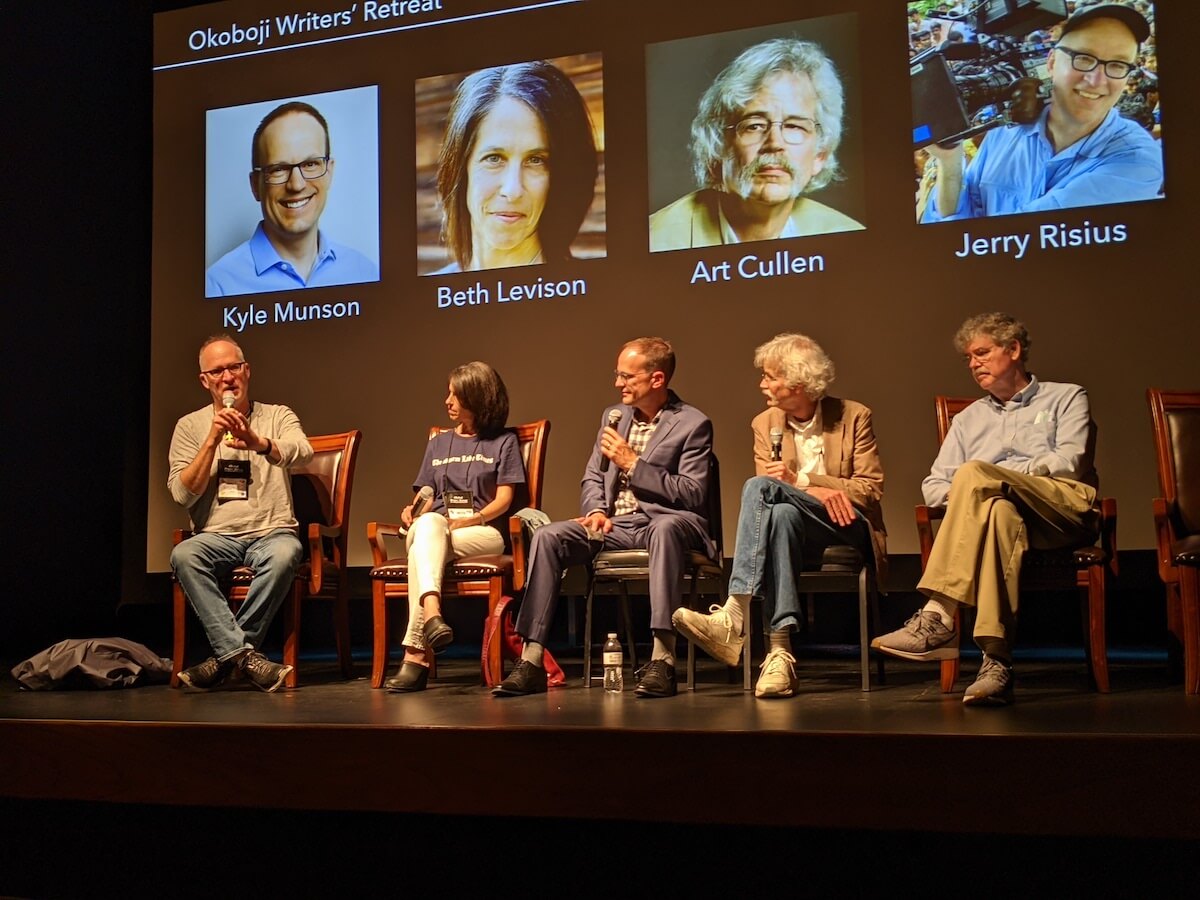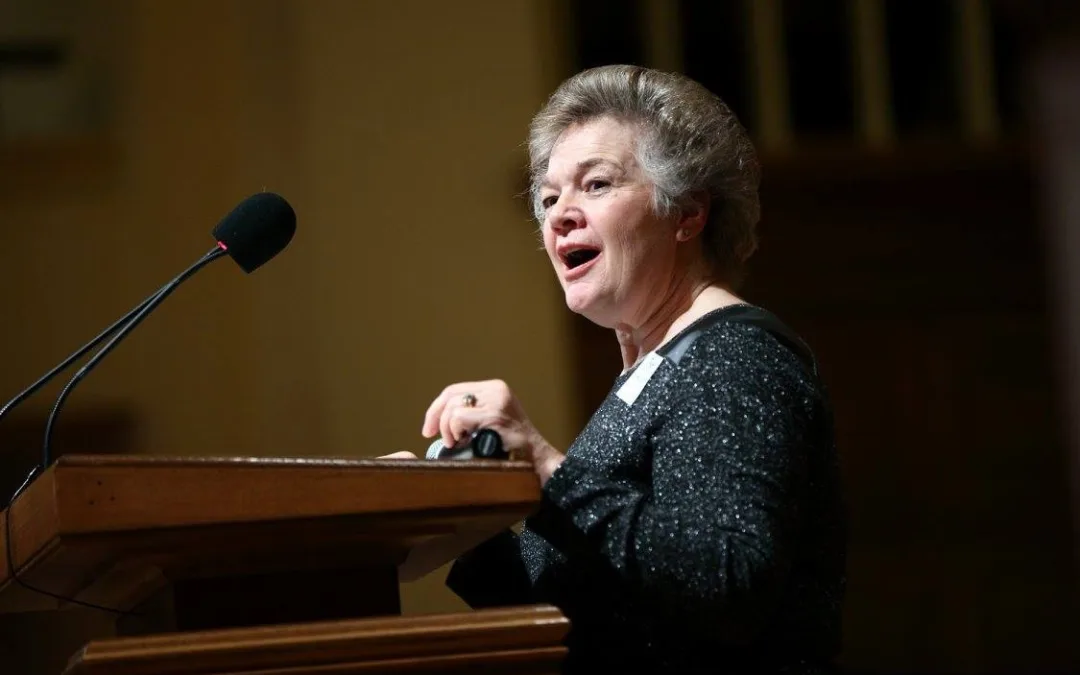
Photo by Starting Line Staff
I honestly couldn’t tell you the last time I became really emotional in a movie theater before I saw “Storm Lake” on Monday.
This is not me pretending I’m some super macho guy who doesn’t ever cry or express his emotions; I just don’t get teary in theaters. However, if I’m at home, it is no-holds-barred with the waterworks. I’ve teared up from plenty of cartoons and even some commercials—curse you Google!
For the uninitiated, “Storm Lake” is an 85-minute long film chronicling The Storm Lake Times newspaper and the Cullen family, including Art.
Art, a quick-witted and lanky mustachioed old-school gumshoe journalist, serves as editor of the family-owned newspaper and won the 2017 Pulitzer Prize for editorial writing.
[inline-ad id=”1″]
I was able to attend Monday’s screening at the Pearson Lakes Art Center as part of the events related to the Okoboji Writers Retreat—I was there to serve as one of the speakers/coaches—put on by former Des Moines Register columnist Julie Gammack.
Art and his brother, John, former publisher of the Times, joined us for the screening as did co-directors Beth Levison and Jerry Risius, a Buffalo Center native.
The quartet answered questions after the movie was shown. I got more emotional than I expected when I asked Levison and Risius how they were able to capture the essence of community journalism on film and showcase just how vital it is.
Beth had a really simple answer that also sums up the biggest thing about being a good community journalist: “Just being there.”
She’s right.
[inline-ad id=”2″]
My professional journalism career has been community-based with stops in Newton, Sheldon, Sioux City, and Sheldon again. A big part of my job and that of the other reporters, editors, photographers, designers, ad reps, etc. I had the privilege of working with was being there and having a pulse on the community.
Watching “Storm Lake” almost seemed like an out-of-body experience at times. It really felt like I was watching myself work when I saw Tom Cullen—Art’s son and a Times staff writer—cover various public meetings, work the phones, walk the beat, communicate with sources, and be the last man in the office during the night of the 2020 caucus.
There’s a scene where Art calls Tom over to offer some pointers on his story and I’ve been both Art and Tom in that situation, although more often than not I’ve been Tom, something my former editor Jeff Grant can attest to.
[inline-ad id=”3″]
There are obvious notes most journalists would pick up on, but “Storm Lake” showcases some of the uniqueness that comes with working at a community newspaper. Community journalism is not glamorous, but it is important and can be a hell of a lot of fun.
One day, you’re hosting a presidential candidate in the office the next day you’re at a school taking a picture of a piglet in a diaper. That same week you also might write about road construction, a longtime business closing, or a local who found success elsewhere.
Working in a community paper will keep you humble and you learn quickly that you are not too big for any story nor is any story too small for the paper.
This was a lesson I learned early in my career and one I’ve shared before, but that I will share again because it breaks down what community journalism is about as well as any textbook.
[inline-ad id=”4″]
I covered the Jasper County Board of Supervisors for the then-Newton Daily News and for two community weekly papers in the county under the same umbrella. Board meetings were at 9 a.m. on Tuesdays, which was also deadline day for the weekly papers, meaning I had to turn those meeting stories around pretty quickly.
I was the only one in the newsroom and trying to finish up a board meeting story when one-by-one all the newsroom phones started ringing until the persistent caller finally reached me. It was one of the gals in circulation. An older woman had come over to the circulation building because she couldn’t climb the stairs to the main office and wanted someone from the paper to take a picture of her and an extremely long green bean she grew in her garden.
What?
I was hot! Here if I was on this extremely important deadline for a meeting I can’t even remember now and this woman wanted me to take her picture and put it in the paper because she had an extraordinary large vegetable?
The nerve, I thought!
[inline-ad id=”5″]
Frustrated, I grabbed a camera, went to circulation, and my anger subsided once I saw this woman. She was an older lady with a head full of white hair who used a cane to get around—hence why she didn’t want to use the stairs—and she was absolutely beaming with pride while showing me her 22-inch long green bean.
According to her, the green bean’s seed originally came from a package she purchased in Hawaii 20 years earlier but had misplaced. Once she found it, she decided to plant it to see if the seeds were still good, which they apparently were, and then some.
I snapped her picture and we ran it in the paper. I don’t remember a single soul in the community talking to me about that week’s supervisors’ meeting; however, I recall a number of conversations about the green bean lady.
Taking a picture of giant produce—or in the case of the Times, the big fish—is what community journalism is all about, and “Storm Lake” represents that: The good, the bad, the ugly, and the City Beautiful.
by Ty Rushing
09/24/21
[inline-ad id=”0″]
Politics

Biden marks Earth Day by announcing $7 billion in solar grants
The Biden administration on Monday announced the recipients of its Solar For All Program, a $7 billion climate program that aims to lower energy...

6 terrifying things that could happen if the Comstock Act is used to target abortion
Does 1873 sound like a really, really long time ago? Well, that’s because it is—but if Republicans and far-right anti-abortion activists have their...
Local News

No more Kum & Go? New owner Maverik of Utah retiring famous brand
Will Kum & Go have come and gone by next year? One new report claims that's the plan by the store's new owners. The Iowa-based convenience store...

Here’s a recap of the biggest headlines Iowa celebs made In 2023
For these famous Iowans, 2023 was a year of controversy, career highlights, and full-circle moments. Here’s how 2023 went for the following Iowans:...





